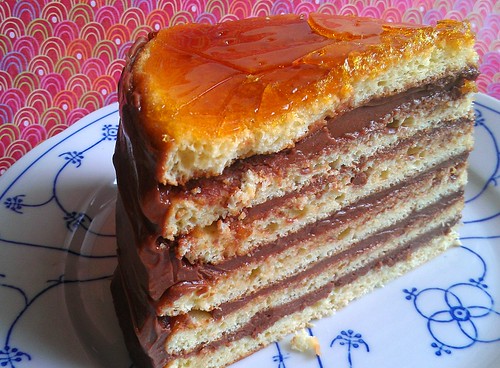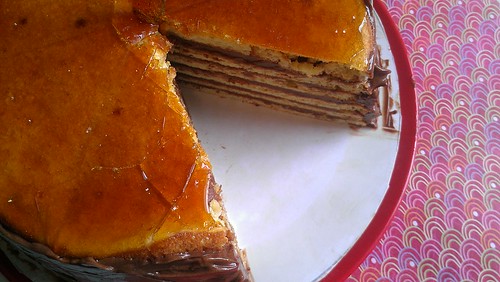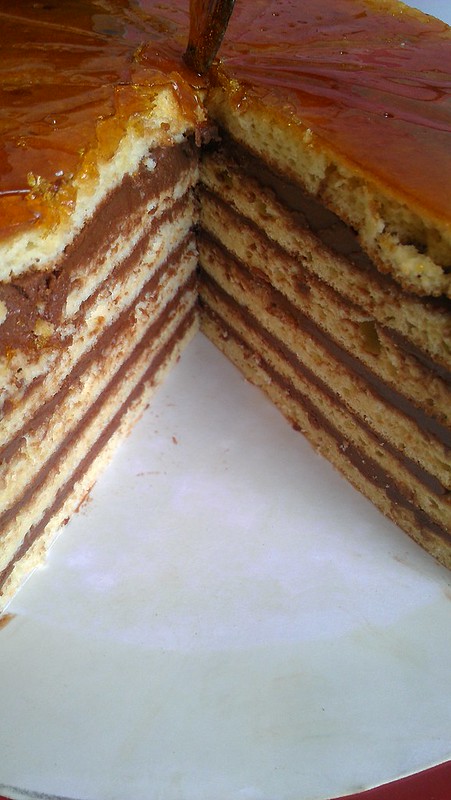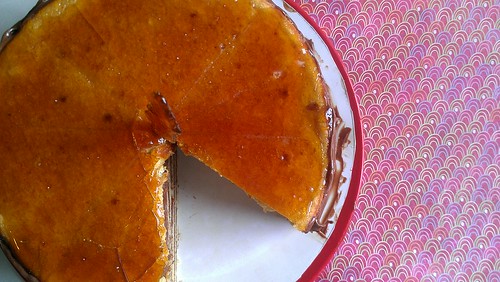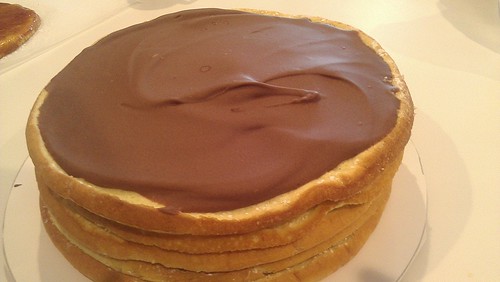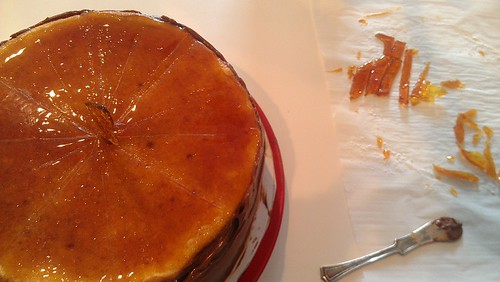He may not have had nine lives, but József C. Dobos left a many-layered legacy that's considered a symbol of Hungary. It's called Dobos Torte, an elegant caramel-coated cake which, when cut into, becomes even better--because once you get past that eloquent exterior, you'll find several (between 7 and 11) layers of delicate sponge cake sandwiched with a luscious chocolate buttercream.
Sometimes thought of as the Hungarian equivalent to Escoffier, the famous French foodie who was the inventor of, among other dishes, Cherries Jubilee, Dobos was a fancy chef from a long line of fancy chefs. After spending his life in the culinary arts, he settled down in his later years to open a gourmet food shop in Hungary. He created this cake as a pleasurable way to satisfy the need for a dessert that would keep well: refrigeration wasn’t as easy to come by as it is today, and the high ratio of rich frosting to cake ensured that the cake would stay moist for far longer than a plain sponge cake.
But that wasn't the only selling point of the cake: Dobos, a true pastry pilgrim, had discovered buttercream in his travels to France--ooh la la! When he used it in his cake (at a time when most cakes were filled with cooked creams or custards), the sinfully luxuriant, sweet buttercream-filled Dobos Torte stood out. That's right: while the combination of cake with buttercream filling is commonplace today, at the time it was really quite a revolutionary dessert concept!
Mr. Dobos also seemed to be quite the marketing expert for his time: after he grandly introduced his Dobos Torte at the National General Exhibition of Budapest in the 1880s, the cake became a sensation throughout Europe, earning devotees from far and wide. Dobos, like a modern-day pastry rock star, even toured European capitals, introducing the cake to different cities and presenting it in a special, custom-made container. Talk about hyping your brand!
Dobos went to the great meringue in the sky in the 1920s, but his very unique cake has lived on: among the many honors bestowed on him and his creation over the decades, my favorite remains the time when a six-foot-diameter Dobos torte was paraded by pastry chefs through the avenues of Budapest! Dobos torte remains a classic today; look for it when you're traveling the world, visiting fancy hotels, restaurants, and pastry shops.
When it comes to making Mr. Dobos' creation yourself, don't be daunted by the long list of ingredients and instructions: this is definitely a recipe that requires time and attention, but it's not very difficult to prepare, and once it's served, you'll secure a spot as baking royalty among your family and friends. The crowning glory is the caramel top layer, which, when applied, will undoubtedly make you feel as if you are adding the torch to the Statue of Liberty.
Full disclosure? When I made this cake, I made it slightly wrong. Usually the caramel is cut as triangles and then placed at a rakish angle along the cake's top, like this. I made it as a topping layer. You know what? Still tasty, even if not quite 100% traditional. So I have it that way in my tutorial!
Dobos Torte (Printable version here!)
Makes one tall 9-inch layer cake (16 servings)
For the cakes:
- 9 egg whites
- 1 cup granulated sugar
- 8 egg yolks (use the last egg yolk for the buttercream)
- 1/4 cup milk (whole or 2%)
- 1 tablespoon lemon zest, from 1 large lemon
- 1 1/2 teaspoons vanilla extract
- Pinch of salt
- 1 1/2 cups all-purpose flour, sifted
- Confectioners' sugar, for dusting
For the buttercream:
- 12 ounces bittersweet chocolate, chopped (about 2 cups)
- 1 cup sugar
- 1/4 cup water
- 2 large eggs
- 1 egg yolk
- 1 pound (4 sticks) unsalted butter, cut into pieces
For the caramel:
- 1 cup granulated sugar
- 3 tablespoons water
Preheat the oven to 400 degrees F. Generously grease and flour the bottom and sides of a 9-inch springform pan. Have ready two 10-inch cardboard circles.
To make the cake, put the egg whites in the very clean bowl of a stand mixer fitted with the whisk attachment. Beat the egg whites until frothy, then gradually add the sugar. Continue beating just until soft peaks form. Transfer to a large, wide bowl to make later steps (folding, etc) easier.
In another bowl, whisk the 8 egg yolks with the milk, lemon zest, vanilla, and salt until well blended. Fold about ¼ of the egg yolk mixture into the egg whites to lighten the mixture; fold in the rest of the yolks in a second addition. This will keep the mixture from deflating. Sift the flour over the egg mixture, and fold in two additions, making sure that the flour has been completely incorporated.
Measure about 1 cup batter into the prepared pan, then spread and level it, using an offset or rubber spatula. Bake for about 4 to 7 minutes, or until lightly browned on the edges, with a dull finish on top, and the cake has begun to pull away from the edges of the pan slightly. Remove the cake from the oven, and let sit for a 3 to 4 minutes before removing the layer from the pan with a metal spatula. Dust the cake lightly with confectioners' sugar (this will keep the layers from sticking), and place on a rack to cool.
Clean and grease the pan; repeat this process until all of the batter is used, about 6 times more. As you bake, stack the layers between waxed or parchment paper, and cover with a clean towel. Refrigerate the layers until completely cold, about 2 hours.
To make the buttercream, start by melting the chocolate in a heavy-bottomed saucepan over low heat, or in the top of a double boiler. Stir slowly and constantly until the chocolate melts. Set aside.
Using an electric mixer, whisk the eggs and egg yolk on medium-high speed until they reach the ribbon stage (“ribbons” will drip when you hold up a whisk, rather than just drips). Turn off the mixer, but leave the egg mixture in the bowl.
In a small saucepan combine the sugar and water, stirring until the sugar is dissolved. Stop stirring and let the mixture come to a boil; cook to 240 degrees (the soft-ball stage) on a candy thermometer Take pan off the heat.
Return to the egg mixture. Whisk on low speed,and pour the hot syrup into the egg mixture in a slow but steady stream. Increase the mixing speed and whip the mixture until it is roughly the texture of whipped cream and has cooled to room temperature (the mixing bowl may still feel slightly warm). Add the butter in 3 parts, stirring so that it gets mixed in. Then add the melted chocolate (it should be just slightly warm). Continue to whip until smooth and well blended.
To assemble the cake, start with one layer of cake; set it on one of the 10-inch rounds; cover the top surface with some buttercream ( a slightly overflowing 1/3cup), and then press down with another layer to make a good seal. Repeat this with all but one of the cake layers. Wrap the torte in plastic, and refrigerate for at least 6 hours; also wrap and chill the remaining buttercream (you should have about 2 cups left). Place a sheet of parchment paper on top of the other cardboard round, and place the last layer on it; wrap and refrigerate.
To make the caramel topping, in a medium saucepan, cook the sugar and water over moderately high heat, stirring occasionally, until an amber caramel forms, about 5 minutes.
Unwrap the single cake layer. Carefully pour the caramel over the cake layer and spread it thinly, using a small offset spatula. Don't worry if some of it drips off of the cake while you spread it. Working quickly, use an oiled or buttered sharp knife to indent the top of the caramel into 16 wedges (this will ensure that the caramel doesn't crack when you cut slices). Allow to cool slightly, and then retouch the indents with the knife again. Place the layer onto a countertop dusted with confectioners'sugar, and allow the caramel to cool completely.
Place more buttercream on top of the chilled torte, and top with the caramel round. Frost the sides with the remaining buttercream. Cover loosely, and chill the torte for about an hour before serving; let come to room temperature before serving.
Store, loosely covered, in the refrigerator, for up to 3 days.

